skip to main |
skip to sidebar
This used to be a speciality of my paternal grandmother, passed on to her daughter and her three daughters-in-law (one of whom is my mother). I wont say it's a totally unique recipe, but as far as I know, my other grandmother never made this, and none of my maternal relatives do so either. Let's say it's a recipe that is tradition only on my dad's side of the family.
And believe you me, it's a recipe well beloved of my siblings and cousins. We all happen to like green plantains, so that helps. They go a step further (my cousins) and even relish it boiled, seasoned and mixed with fresh grated coconut - something that fills me with acute dislike because of the coconut. Dislike for the recipe, mind, not my cousins - they're some of my favourite people in the world, despite their sometimes odd tastes!
My favourite way to have this kootu is with plain steamed rice with a side of microwaved poppadums and a yogurt pachadi (raita) made with baby green mangoes pickled in brine (maavadu or vadu manga, in Tamil).
Usually my mother makes the pachadi with the mangoes that have gone soft and squishy - she grinds them up with a little coconut and a few other ingredients and mixes the resulting masala with yogurt/curds. A neat way to make use of something that would otherwise be discarded. I'm not sure of the exact recipe for the pachadi... but since I dont have the pickled mangoes with which to make it, I cant say I feel the lack!
Preparing the plantains is a somewhat sticky, messy job. I have to say it's not my most favourite task. Greasing my hands and the blade of my knife helps, but does not entirely stop the juices from the peel sticking to your fingers and turning black. But the oil makes it easier to scrub the residue off at the end. Messy task or not, I personally feel it's worth it once in a while, just for the kootu.
Here's how I prepare the plantains (known as Saba banana in the US, according to info received):
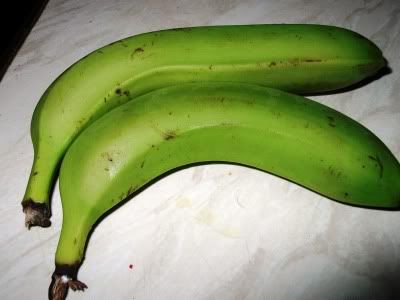
Take two medium plantains and cut them in half, chop off the ends. Use a sharp knife to pare off the thick green peel, starting with the ridged parts. Try to take off as little flesh as possible (both yours and the plantain's - or you'll end up losing blood and/or losing a great deal of the edible white part!). Keep a bowl of cold water handy in which to dunk the peeled plantains, or they'll get badly discoloured.
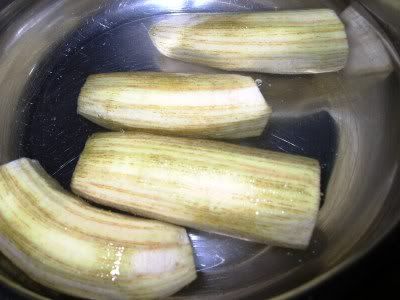
Chop the peeled plantains into small cubes. Keep 'em dunked in the water.
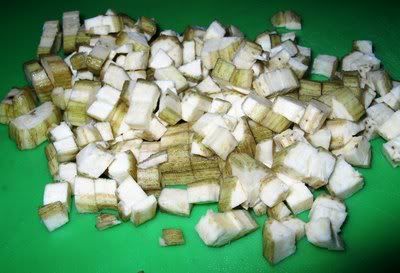
Now go on to the recipe.
Recipe for: Vazhakkai kootu (green plantain "stew")
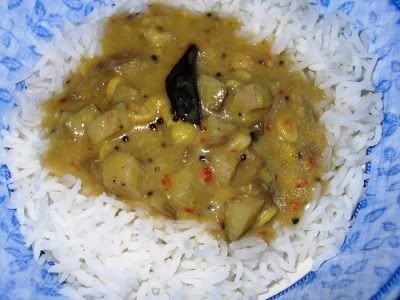
Ingredients:
2 medium green plantains, peeled and chopped
1 tsp tamarind paste dissolved in 3 cups water
4 tbsp chana dal (bengal gram)
1/2 tsp turmeric powder
1 cup tuvar dal (red gram dal), cooked and mashed well
For the masala paste:
2 tsp urad dal
5-6 dried red chillies (or to taste)
2 tbsp fresh grated coconut
1 htsp rice flour
Salt to taste
4-5 tbsp warm water
For tempering:
1 tsp oil
2 tsp mustard seeds
6-7 curry leaves
2 tsp urad dal
1/4 tsp asafoetida powder
Method:
1. Grind the masala ingredients to a fine paste using 5-6 tbsp warm water. Set aside.
2. Put the chana dal and the chopped plantains in the tamarind water along with the turmeric powder, and bring to a boil.
3. Lower the heat to a simmer and let it cook until the plantain pieces begin to look sort of translucent. (Skim off any foam that appears on the top). It's cooked when the pieces hold their shape but can be easily mashed between two fingers.
The chana dal ought to be cooked to more or less the same texture by now - holding its shape but easily mashed between two fingers. If not, close the pan with a lid and let simmer for 3-4 minutes longer.
4. Now mix the coconut masala paste with the cooked tuvar dal, using a little water to make it pourable, and mix this with the cooked plantains. Add salt to taste and let the mixture simmer for 4-5 minutes longer.
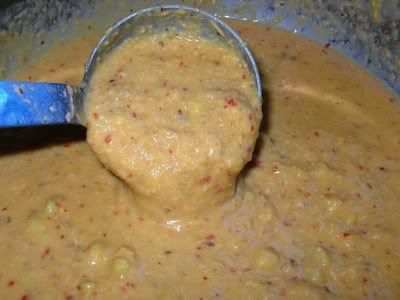
The cooked tuvar dal-coconut masala mixture
5. In the meantime, heat the oil in a little pan and add the tempering ingredients. Cover and let the mustard seeds pop, then pour the contents onto the cooked kootu immediately, so that it sizzles.
Stir and serve hot with plain steamed rice, pickle and poppadums.
Jamaicans aren't the only people who eat plantains or unripe green bananas... Tamil Nadu State and Kerala - especially Kerala - have a variety of recipes for these starchy vegetables. There's a difference between plantains and green bananas - they're known in Tamil as "nendrankai" and "vazhakkai", respectively. The difference as far as I know is that plantains are very hard when they're green, and are good for making chips, and green bananas are usually not quite so hard - they make good banana chips too, but are easier to cook in general. More tender.
Me and my siblings all love green bananas/plantains cooked any way that my mother makes it. The only way in which I WILL not eat them is boiled and mildly sauteed and then mixed with fresh grated coconut - my grandmother's speciality... bleagh!!! to put it mildly. Not that I dislike the combination of coconut and bananas... it's just that I prefer the coconut ground to a paste and used to make a gravy for the bananas. Vazhakkai kootu, in other words. But that's not what I made today.
Usually I get the hard plantain variety for making "podimas" - they retain their shape better and dont get over-soft when they are pressure-cooked. Makes for much easier grating, although you do have to be careful that it doesnt get too dry after being grated. In that case it might taste like seasoned wood-chips.
Anyway... I didnt have the nendrankai, so I used vazhakkai this time. I was careful not to pressure-cook them for more than 2 whistles, but they were still quite soft. So I let them cool completely before grating them... however, I couldnt quite avoid bits breaking off in lumps. It wasnt a problem of anything but aesthetics, though. Tastes a lot better than it looks!
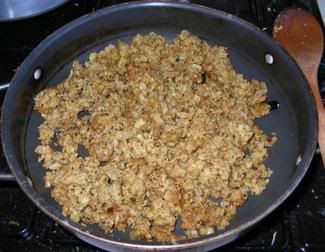
The recipe for the masala powder used to season the cooked, grated bananas is my mother's version. I cant better it, so I'm not even going to try. One of my favourite South Indian-style meal combinations (and I'm sure my sister and brother would agree) is mor kuzhambu (buttermilk-based gravy) and vazhakkai podimas with plain white rice. What I'd call a comforting classic.
Recipe for: Vazhakkai podimas
Ingredients:
1 big green plantain or 3-4 unripe green bananas
2 tsp urad dal (white)
2 tsp black mustard seeds
1/2 tsp turmeric powder
3 tbsp sunflower/vegetable oil
2 tbsp coconut oil (optional)
Salt to taste
a few fresh curry leaves
For the masala powder -
2 tsp chana dal
2 tsp urad dal
2 tsp coriander seeds whole
1/2 tsp black peppercorns
4-5 dried red chillies (more or less according to taste)
a pinch of asafoetida powder (optional)
a few fresh curry leaves
Method:
1. Dry-fry the masala powder ingredients till the the dals turn pale brown/red. Cool and grind to a fairly smooth powder in a spice mill.
2. Cut off about a half-inch from each end of the banana(s) and then cut them in half.
3. Pressure-cook them for 2 whistles (or 5 minutes at full pressure). Cool completely.
4. Peel the skin off the banana pieces - it should come off very easily - and grate the bananas.
5. In a wide-bottomed pan, heat the oil. Add the turmeric powder, mustard seeds, urad dal and curry leaves; cover and let the mustard seeds splutter (about 30-45 seconds) on high heat.
6. Turn down the heat and add the grated bananas. Mix well, taking care not to mash the bananas too much.
7. Now add about 3-4 tsp of the masala powder and salt to taste, and stir well so that it's well mixed with the vegetable.
8. Fry on medium heat for a few minutes, then pour the coconut oil (if using) over as much of the mixture as possible. Mix once more.
9. Cook on medium until crisp golden spots start to appear on the bottom layer. Serve hot with sambar/mor kuzhambu and white rice.
Note: You can double the quantities of the masala powder and store it tightly sealed for future use. It works well even with fried potatoes, Indian style.







